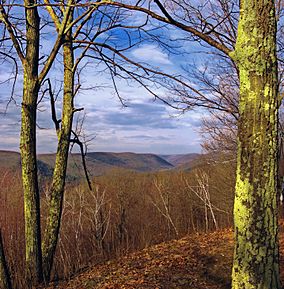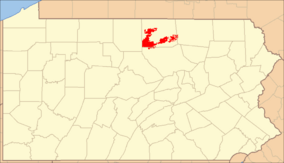Tioga State Forest facts for kids
Quick facts for kids Tioga State Forest |
|
|---|---|

Babb Creek Canyon, Tioga County, as seen from the Mid State Trail at Gillespie Point.
|
|

Location of Tioga State Forest in Pennsylvania
|
|
| Location | Pennsylvania, United States |
| Area | 164,975 acres (667.63 km2) |
| Elevation | 2,119 ft (646 m) |
| Established | 1900 |
| Named for | Tioga River |
| Governing body | Pennsylvania Department of Conservation and Natural Resources |
| Website | Tioga State Forest |
Tioga State Forest is a large, beautiful forest in Pennsylvania, United States. It is part of the Pennsylvania State Forest system. This forest is located in the Allegheny Plateau region, mostly within Tioga County, Pennsylvania.
The main office for Tioga State Forest is in Wellsboro. This town is also in Tioga County, Pennsylvania.
The forest gets its name from the Tioga tribe. They were a group of the Seneca, a Native American people. Their homeland was in this region long ago. In the Seneca language, the word "Tioga" means 'the meeting of two rivers'.
Before July 1, 2005, Tioga State Forest was even bigger. It included almost all state forest lands in Tioga County and Bradford County. At that time, it covered about 160,000 acres (64,750 ha). After a change in how Pennsylvania's state forests were organized, the lands in Bradford County became part of the new Loyalsock State Forest. Today, Tioga State Forest is mostly in Tioga County. It also includes small parts of Bradford and Lycoming Counties.
Contents
Forest History and Conservation Efforts
Tioga State Forest was created because Pennsylvania's forests were being used up very quickly. This happened during the mid-to-late 1800s. People who cared about nature, like Dr. Joseph Rothrock, worried that the forests would not grow back. They knew this would happen if the forests were not cared for properly.
Early Logging and Forest Damage
Lumber and iron companies cut down huge amounts of old-growth forest. They used a method called clearcutting. This left behind only dried tree tops and rotting stumps. Sparks from passing steam locomotives often started wildfires. These fires stopped new second growth forests from growing.
Conservationists were afraid the forests would never recover. They wanted a new way to manage the forests. They asked the state to buy land from the lumber and iron companies. The companies were happy to sell because they had already used up the natural resources.
Beginning of State Forests
Changes began in 1895. Dr. Rothrock became the first commissioner of the Pennsylvania Department of Forests and Waters. This department is now called the Pennsylvania Department of Conservation and Natural Resources. In 1897, the Pennsylvania General Assembly passed a law. This law allowed the state to buy land for "forest reservations." This was the start of the State Forest system we have today.
Most of the land bought by Pennsylvania came from land-holding and lumber companies. These companies had cut down huge amounts of old Eastern hemlock and white pine trees. This happened during the lumber boom of the mid-to-late 1800s. The cut timber was floated down Pine Creek and its smaller rivers. It went to the Susquehanna Boom near Williamsport.
The lumber companies left behind land with few trees. It was covered with tree stumps and dry tree tops. These materials easily caught fire. Wildfires slowed the growth of new trees. Today, the forest is thriving with second growth forests of hardwood trees.
The Civilian Conservation Corps' Role
The establishment of the Civilian Conservation Corps (CCC) was very important. President Franklin D. Roosevelt started the CCC during the Great Depression. The CCC helped the forests of Tioga State Forest recover.
Several CCC camps were set up throughout Tioga State Forest. Young men in the CCC worked hard. They cleared dried bushes and debris from the forest and streams. They also built roads and trails throughout the forest. The CCC also built the recreation areas you can find at Leonard Harrison and Colton Point State Parks. These parks are located along the Pennsylvania Grand Canyon.
Birch Oil Industry
During the mid-1900s, Birch trees in Tioga State Forest were used for the birch oil industry. People built birch stills throughout the forest. These stills produced oil. This oil was used as a lubricant in factories. The last birch still in Tioga State Forest closed in 1972.
Neighboring State Forest Districts
Tioga State Forest shares borders with other state forests and even another state.
- The U.S. state of New York is to the north.
- Loyalsock State Forest is to the east and southeast.
- Tiadaghton State Forest is to the south.
- Susquehannock State Forest is to the west.
Nearby State Parks to Explore
There are several state parks close to Tioga State Forest where you can enjoy nature.
- Leonard Harrison State Park (Tioga County)
- Colton Point State Park (Tioga County)
- Hills Creek State Park (Tioga County)

